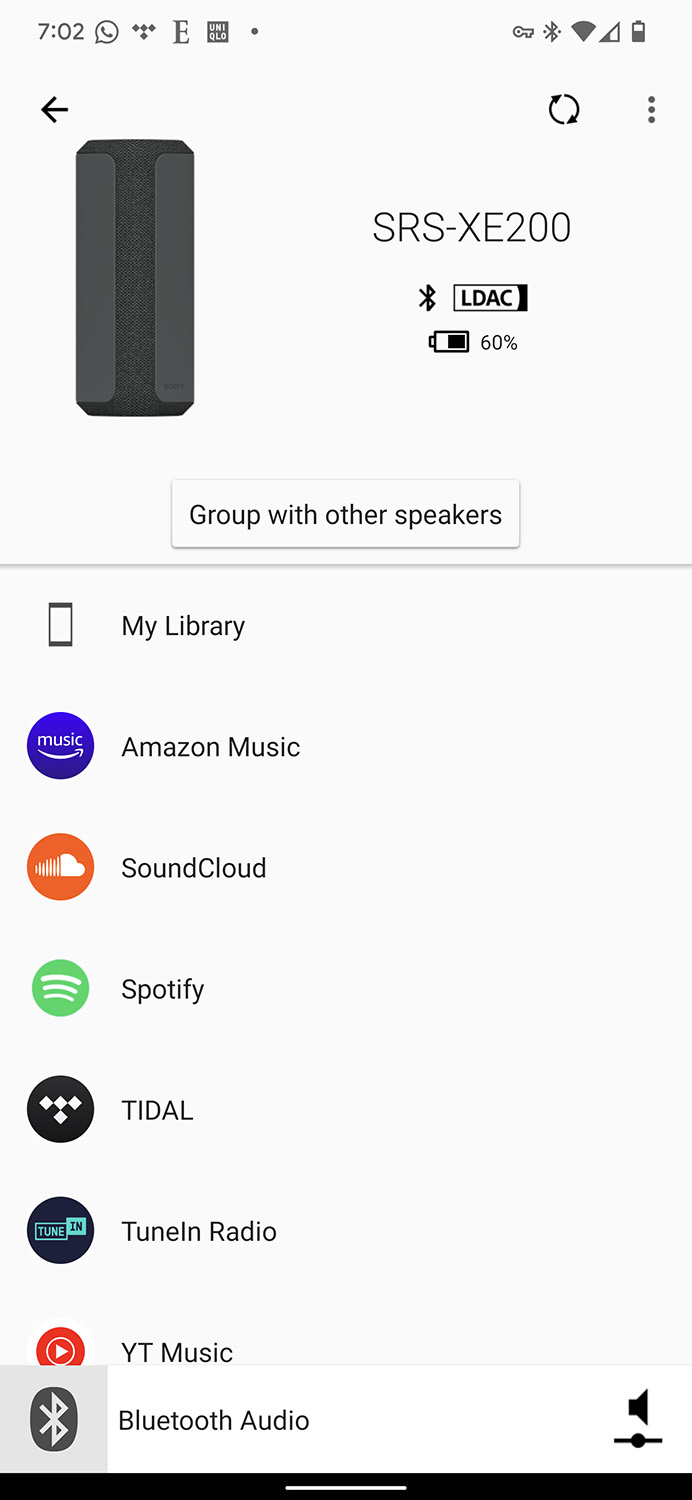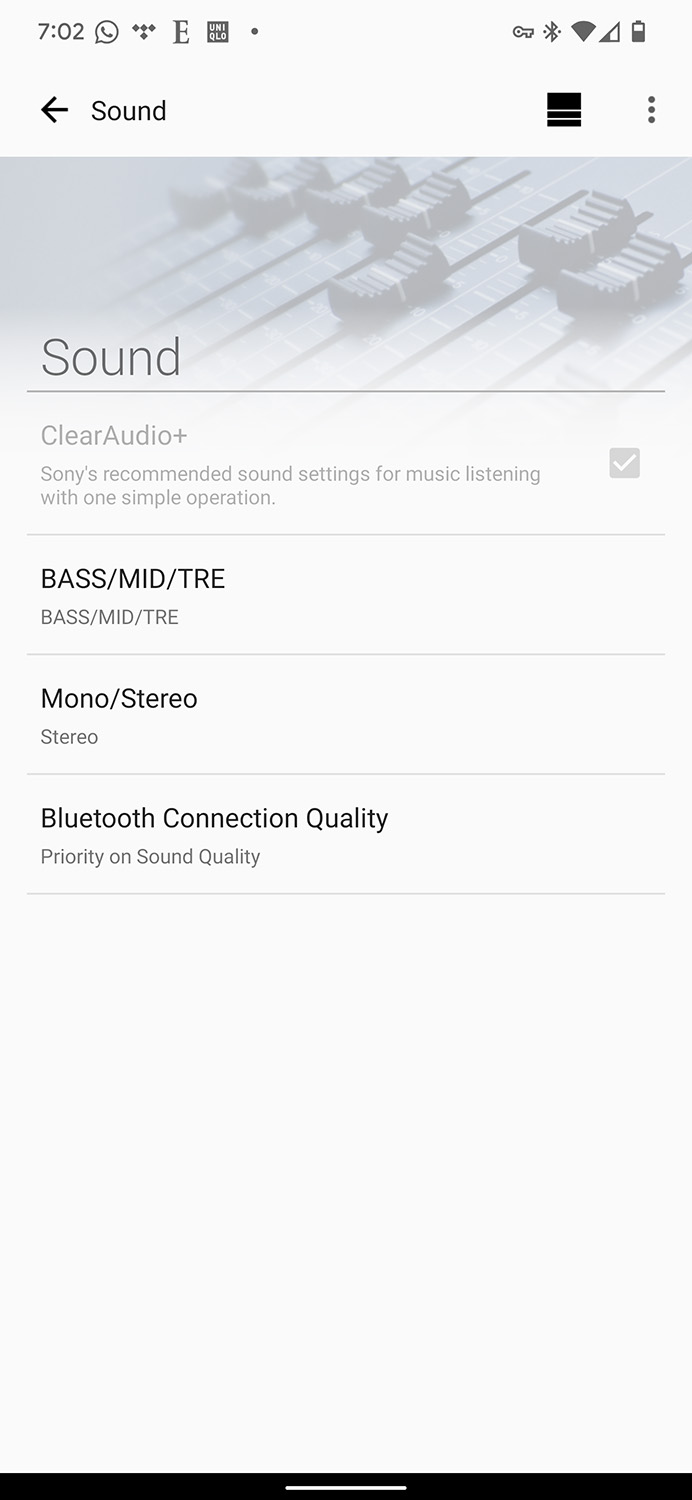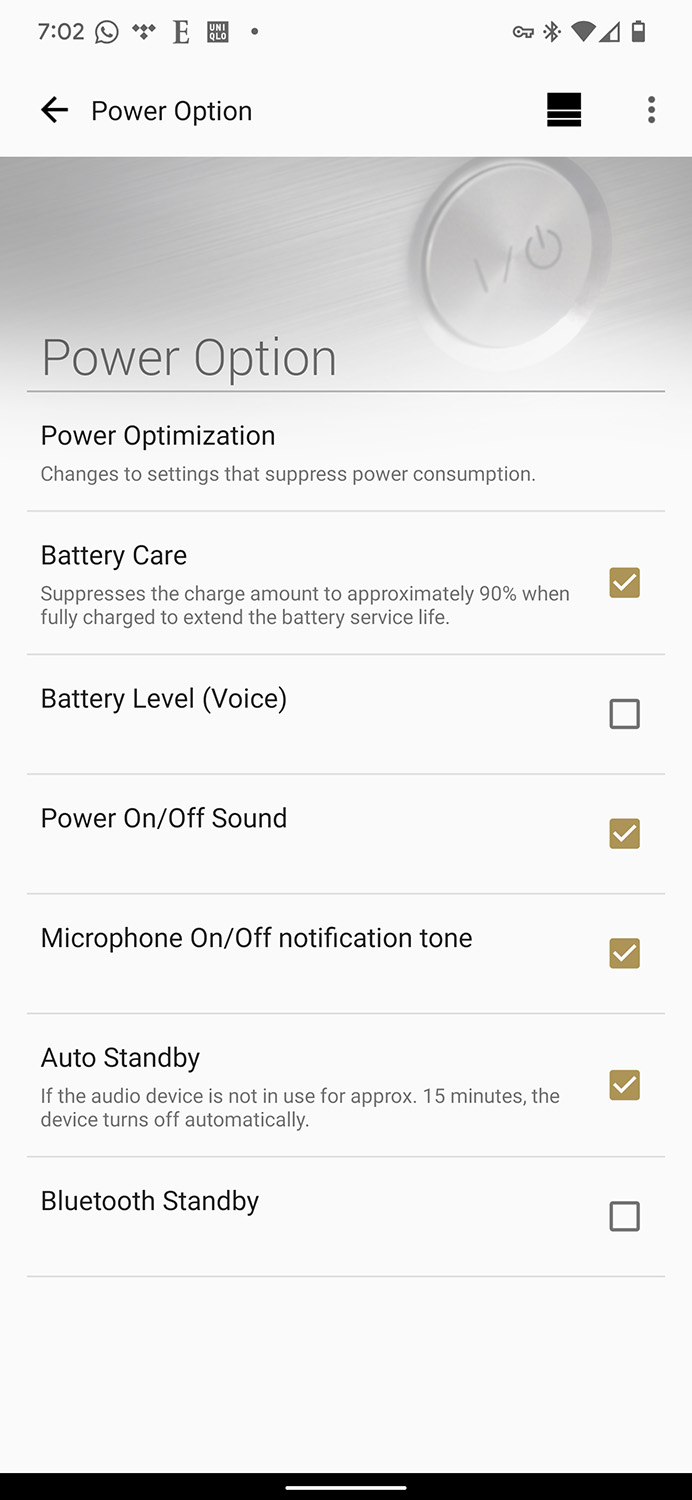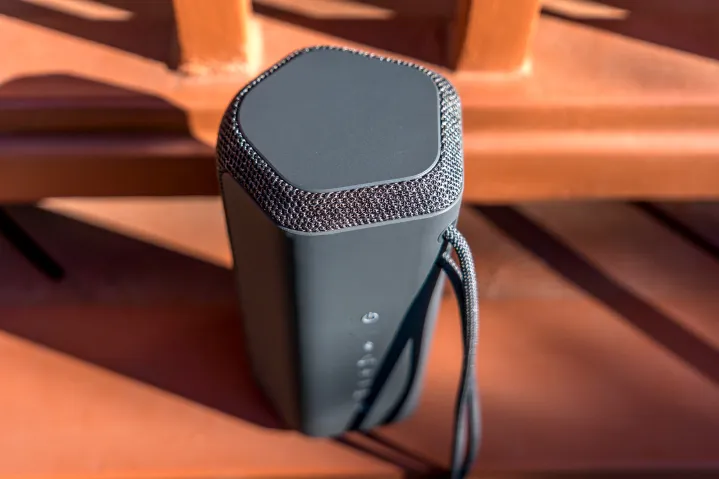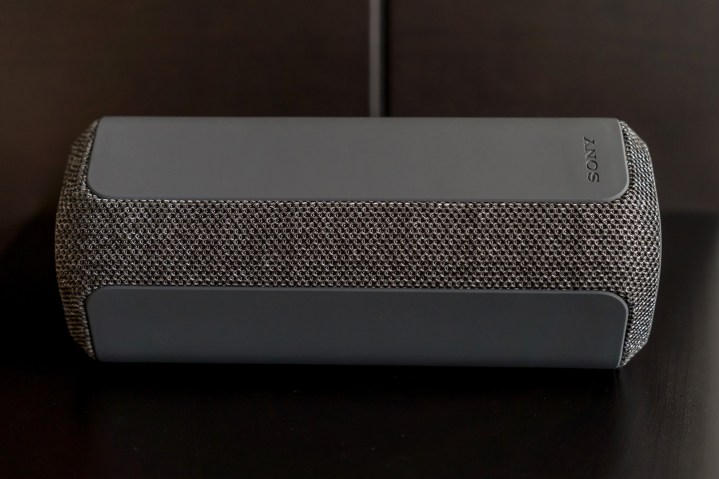- Solid, durable build
- Great sound quality
- Good app support
- Stereo and multi-speaker pairing
- Good battery life
- Sound dispersion is more linear
- Limited audio customization
- Phone calls aren't great
Looking for a small, portable wireless Bluetooth speaker? Sony’s $130 SRS-XE200 — one of the company’s newest and smallest speakers — looks like it fits that Goldilocks zone: small and light enough to go everywhere, tough enough to handle almost any conditions, and it even works as a speakerphone, something that’s getting harder to find on Bluetooth speakers. But is that enough? And most importantly, how does it sound? We put all that to the test.
What’s in the box
Sony packs the XE200 in a box with recyclable materials, which is nice to see. Inside, you get a USB-C charging cable and quick-start guide. The cable is USB-A to USB-C, and there’s no wall charger in the box, so you could plug into any other charger you already have.
Design
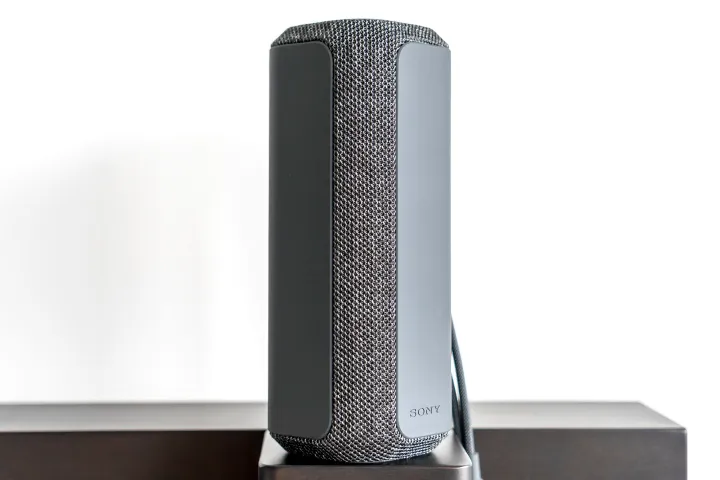
Sony designed the XE200 to be an upright speaker, first and foremost. You can lay it horizontally for optional stereo sound, if you want, but it’s been tuned to deliver its best performance when standing up. It’s trimmed in fabric, whereas the rest of the body is a rubberized silicone that gives the unit some of the IP67 protection it enjoys as a more ruggedized speaker.
It will fit right in at the beach, by the pool, or close by in a tub or jacuzzi. You can dunk it in water, though beware of sand and saltwater getting into the crevices of the fabric. Even though Sony says it built the speaker to resist salt, a good rinse in clear water is wise to wash it all away.
The main consideration is where the sound is actually coming from, and that fabric sliver makes that very clear.[/pullqoute]
The speakers are underneath the fabric sliver running down the middle, while the button controls are arrayed on the side, and the port cover for the USB-C charging port is at the rear. It doesn’t have “feet” at any part of the pentagonal body, suggesting there isn’t a “this side up” orientation to consider whenever you put it down somewhere, unless you use the buttons as a guide. Sony doesn’t specify any particular orientation when placing it horizontally, but if I was to use its own product photos as a clue, I would err on the side of the Sony logo being to your right. Whatever the case, the main consideration is where the sound is actually coming from, and that fabric sliver makes that very clear.
Sony uses what’s called a Line-Shape Diffuser that it says was inspired by concert audio setups whereby the speakers push audio out over a wider area, as in the full 180-degrees of the XE200’s front sliver. The increased sound pressure on the output is supposed to spread sound out wider and further. It’s the company’s X-Balanced technology and non-circular diaphragms that produce the higher pressure, enabling the speaker to push audio out wider than it otherwise might.
At 1.76 pounds, the XE200 isn’t all that heavy, though by portable speaker standards, it does have some heft to it. The dimensions are also a little fatter at 3.54 x 8.19 x 3.7 inches compared to something like the Marshall Emberton II, though not thick enough that you couldn’t just take it with you on a trip or while lounging around at home, indoors or outdoors. The included lanyard — or strap, if you look at it that way — allows you to keep it close or hang it somewhere if you want to position it that way.
The control layout is pretty easy to figure out. The power button is at the top, followed by Bluetooth, playback/calls, volume up, volume down, battery, and mute. The quick-start guide points out some extras you should note, like how double-pressing the playback button will skip forward to the next track, while triple-pressing skips back. Press the battery button and a voice will pipe up to tell you how much you have left. Press and hold it, and the speaker turns on Stamina mode to preserve battery.
By default, the XE200 is in Ambient Noise Sensing mode, which is more useful in outdoor settings because it uses the onboard microphone to listen for ambient sounds that might affect audio quality and makes adjustments without sapping too much battery life. I’m not sure I heard a big difference with it on or off, but it’s there in any case.
Sony essentially used the same design and features for the larger XE300. Other than its larger body and louder sound, it looks and feels like a bigger brother to the XE200. You get four color options with the XE200: black, light gray, blue, and orange. My review unit felt more like charcoal than black to me, personally.
Setup and app controls
Google Fast Pair will get the XE200 going with Android devices in little time. It’s similar with iOS devices, save for the fact you have to pair in the Bluetooth menu first. After that, Sony’s Music Center app is the place to go to control what this speaker can do. It lists shortcuts to music and audio streaming service apps you have on your phone, as well as “My Library,” which give you access to any audio files you’ve stored on your phone.
The settings menu isn’t all that versatile, though some features do prove useful. Under Sound, you can adjust the bass, mids, and treble using EQ sliders to tune the sound the way you want. Once you do that, however, it turns off Sony’s own ClearAudio+ sound tuning, which is the secret sauce that delivers the relative balance you get out of the XE200 out of the box. You can always turn it back on, though.
There’s also an option to switch from mono to stereo — making the XE200 one of the only speakers in this class to offer both sound modes. In mono, Sony’s diffuser tech comes out more prominently. Set it down horizontally, toggle stereo on, and you get some stereo separation. There’s a slight difference, though I’m not sure it was all that significant for most of the music I was listening to. You get a little more verve out of the highs and mids in stereo, along with a more pronounced resonance at higher volumes, but the vertical orientation in mono felt more spacious to my ears.
Under Power Option, you may want to toggle on Battery Care to limit charges to 90% full, which could help to extend the useful life of the battery. Bluetooth Standby applies when you have the speaker plugged in to charge and you want to access it whenever you’re ready to play audio again. Turn it on in the app, and the power button is supposed to turn orange to signify it’s in that mode. I never got this to work properly in my testing, so I ultimately ignored it. The rest of the choices are pretty self-explanatory.
Thanks to Sony’s Party Connect feature, it’s possible to stereo pair two XE200s for separate left and right channels. I wasn’t able to test that, but I could test the grouping feature with both the XE300 and larger XG300, where all three could connect and play the same content simultaneously. It’s easy to set up in Music Center and works with a wide variety of Sony speakers — basically any one that works with Party Connect is good to go.
Sound quality
Like the XE300 and XG300, the XE200 supports SBC, AAC, and Sony’s own LDAC codec for hi-res playback when and wherever available from devices that also support it. This isn’t the kind of speaker where you can tell nuanced differences from one codec to another, to be honest. Personally, I wasn’t sure if I really discerned any improvement when playing AAC tracks from an iPhone or LDAC ones from an Android phone.
That’s not to say you won’t get stellar sound out of it because you certainly can. Sony opted for a more moderate level of bass from the outset. It’s there, just without skewing too far at the expense of the mids and highs, so what you start out with is a balanced sound profile that comes through impressively. There is better fidelity in the mids in the larger XE300, which I fully expected, but the XE200 holds its own as the smaller of the two.
The Music Center app lets you adjust the EQ if you want more bass, mids, or treble, and I think it’s well worth tinkering with those sliders to gauge whether you get more of what your ears want out of this speaker. Regardless, the clarity is just as easy to appreciate because it doesn’t suddenly drop off at louder volumes. I tested this out by going up to 80%, and while I did detect slight distortion, along with a touch of sibilance at 90%, I came away liking that music didn’t sound like a muddied and muffled mess while doing so.
The key is placement. Unlike other cylindrical Bluetooth speakers trying to spread sound out spatially in one way or another, the XE200 doesn’t really do that. Can you hear it from behind? Sure, but move to within a 45-degree angle of the front and you hear the difference. For that reason, it’s not the kind of speaker I would plop down in the middle of a table. I’d rather place it on an end with the front facing everyone instead.
In fact, if you have somewhere to lay it down away from a table facing a small group, you’ll still get great sound anyway. Even if you place it off to the side, like on a night table, for instance, it will still sound good. It’s when you veer away from that invisible semicircle coming out the front that you lose something.
It is, in many ways, the kind of speaker you can chill out with as much as it is one to entertain a small group, and it doesn’t matter if you’re outside or indoors.I liked the XE200 more standing up in mono than laid out horizontally in stereo, including in the scenarios and use cases I noted here. The sweet spot for the best sound is fairly wide at between 50% and 80% volume, covering your own personal space on the lower end of that scale, and boisterously filling a room at the higher end. It is, in many ways, the kind of speaker you can chill out with as much as it is one to entertain a small group, and it doesn’t matter if you’re outside or indoors.
There’s no Aux-In port, leaving you no recourse if Bluetooth isn’t working for whatever reason. I like Aux-In connections to plug into speakers when watching shows or movies outside on a deck or patio, and in lieu of that, I instead tried streaming the audio via Bluetooth. The lack of a low-latency codec like aptX does show, as I did detect a slight lag along the way — not enough to make content unwatchable, but not in total sync either.
Phone calls are also a mixed bag. You will hear callers just fine, but for them to hear your voice, you need to situate yourself closer to the speaker, and ideally, with the front facing you. It’s not very good at picking up voices from a distance, despite Sony’s assertions to the contrary, and it particularly struggles if you’re both further away from and behind it. For a speaker that includes a feature to sense ambient noise, I expected better results when it comes call quality.
Battery life
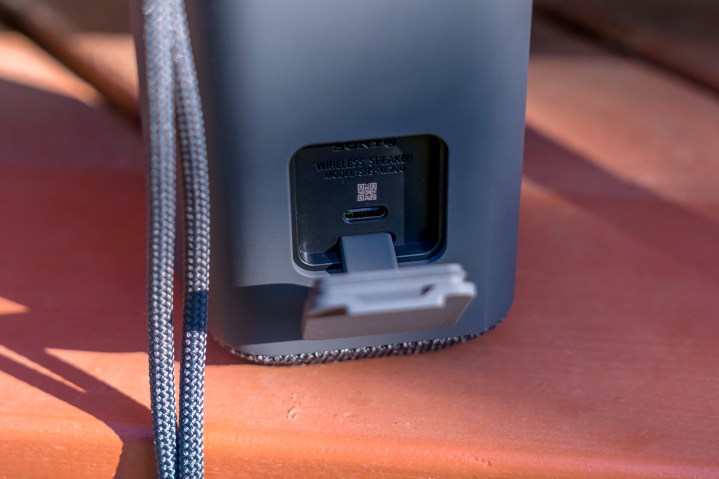
Sony rates the XE200 at up to 16 hours per charge, assuming you don’t raise the volume and leave all default settings as is. Once you start making adjustments, including Battery Care, which limits a full charge to 90%, as well as increasing the bass in the EQ, plus the overall volume, you start knocking that down a peg or two. At 60% to 70% volume, with a V-curve in the EQ to raise the bass and treble, I managed to hit up to 12 hours — still very respectable for a speaker this size. Stamina mode can always extend things further, but you lose out on a lot of the bass, so unless you’re cranking some classical music or listening to a podcast, you probably won’t like how it sounds with it enabled.
If you’re in a rush for some tunes, plug in for 10 minutes and get up to 70 minutes to play them. Again, the same parameters apply, so if you’re pumping up the volume, it won’t make it that far.
Our take
Sony proves that the XE200’s design and engineering isn’t a shot in the dark, putting out excellent audio quality from a well-built speaker. Its $130 price tag isn’t unreasonable for what you get, simply because you can take it with you and enjoy what and how it plays in a variety of situations.
Is there a better alternative?
Bluetooth speakers at this level face stiff competition. If you spend a bit more, you can get a nice bump in sound quality and battery life. Within the family, that means Sony’s own XE300, a taller and heavier alternative that costs $200, but it does go louder and offers better clarity in the midrange.
Moving on to something more the XE200’s size, the $170 Marshall Emberton II is actually smaller, yet pumps out excellent sound with almost double the battery life. It also has the same level of durability and offers a way to stereo pair or group together with other Marshall speakers.
At $130, the JBL Flip 6 is the closest competitor it terms of price. It gets plenty loud and can take a beating doing it. Clearly one of the company’s best wireless speakers, it won’t let you talk to anyone because there’s no speakerphone, but you can stereo pair with other Flip 6 speakers, or group it with other compatible JBL speakers. The battery also won’t last as long per charge, though the JBL app’s EQ does at least give you greater flexibility to tune things your way.
How long will it last?
Sony built this speaker to withstand some punishment courtesy of the IP67 protection, but don’t start throwing it around like a football. It’s got a shockproof body, albeit without the rubberized bumpers on the sides that other speakers have. You can have fun with it in the sand or water, as long as you rinse it clean every time afterward. Sony’s one-year warranty only covers malfunctions, not water damage, so keep that in mind when you bring it out.
Should you buy it?
Yes. It may lack the LEDs and flashy looks of Sony’s larger portable speakers, but it’s small enough and rugged enough to go anywhere, and it doesn’t sacrifice sound quality to do it.



